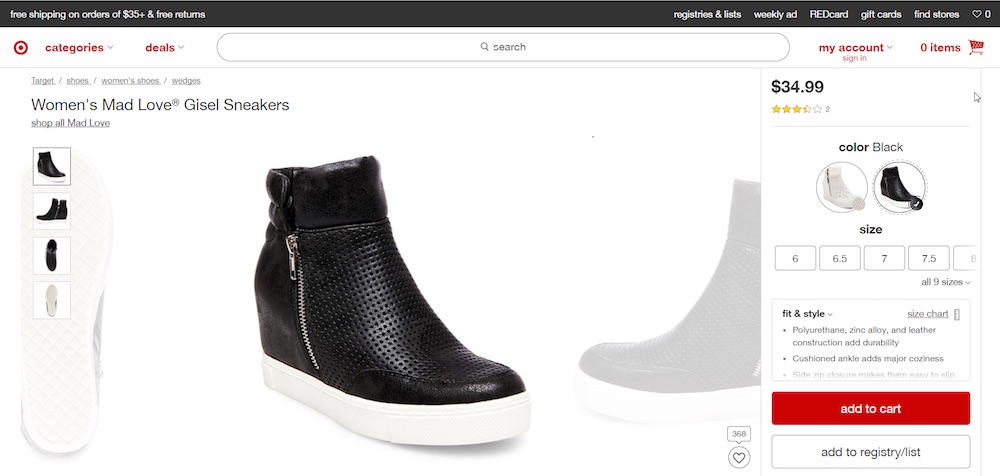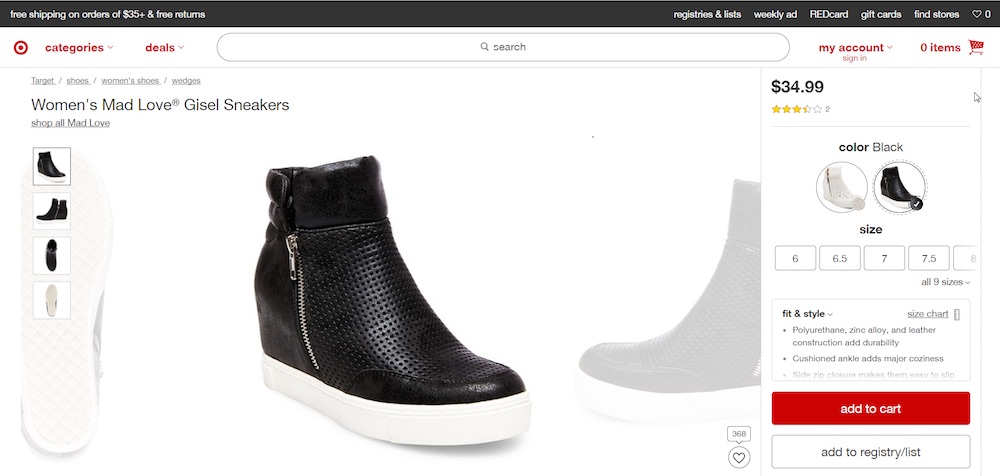The quality of product data impacts natural search performance on ecommerce sites, far beyond whether meta tags are optimized. As a result, the shoe is more closely linked to wedges than to sneakers, though its overall textual relevance is more closely aligned with sneakers based on the product title and how it’s represented in the title tag and the product description. This is another expression of product data within the page. The product name, used as an H2 heading in this page template, is also used as the primary ingredient in the page’s title tag, as well as in its meta description and image alternative attributes. Duplicate Content Depending on the ecommerce platform and how it is implemented, the wedge sneaker product described above could create multiple different and duplicate URLs based on the different categories and click paths under which it can be found, such as: fakesite.com/womens-shoes/wedges/cool-sneaker-123456 fakesite.com/womens-shoes/wedges/sneakers/cool-sneaker-123456 fakesite.com/womens-shoes/sneakers/athleisure/cool-sneaker-123456 fakesite.com/womens-shoes/sneakers/wedges/cool-sneaker-123456 fakesite.com/womens-shoes/sneakers/wedges/lace-up/cool-sneaker-123456 And other combinations of the same categories and attributes. What to Do Next Before worrying too much about duplicate content, identify whether your site exhibits signs that it could benefit from expressing product data via internal linking or labeling on product detail pages. Determine whether your product data is contributing to a duplicate content issue. If there’s a problem, start fixing it. Work with your user experience and creative teams to identify opportunities to insert labeling or linking on your product detail pages. Once you’ve developed relationships to solve some of these complex challenges, consider offering a brown bag on how each team can improve natural search performance in the course of their daily jobs.
The quality of product data impacts natural search performance on ecommerce sites, far beyond whether meta tags are optimized. Product data isn’t traditionally thought of as contributing to SEO, but in ecommerce everything that impacts URLs, internal linking, and textual content also impacts organic search rankings.
Data such as category, group, and attributes are typically assigned to each product when it is loaded into the system. After the initial upload, this data is usually managed by checking the boxes and editing the fields within a product management system. Each of those fields and check boxes triggers different expressions of the product data on the site itself, most of which affect SEO in some way.
Take, for example, the product detail page below from Target.com. It benefits from multiple instances of product data expression. The pair of black wedge sneakers might be assigned the categories of “women’s shoes,” “sneakers,” “wedges,” and “new arrivals.”

Those sneakers could be tagged with the attributes of “lace-up,” the colors and sizes in which they are offered, and the name of the brand that manufactures them. The shoe could also be inserted into a group of “athleisure” products, a trendy fashion style that combines athletic and casual traits into a single product or outfit.
Internal Linking and Labeling
While product titles and descriptions are important to SEO, that’s not the topic of this article. Equally important and harder to see, product data affects how products are classified, interlinked, and labeled. Where a product is linked contributes to its contextual relevance.
A shoe is more likely to be understood by search engines as a sneaker and a wedge if it’s linked within navigation that labels it as a sneaker and a wedge, in conjunction with the product detail page itself containing descriptive text that labels it as a wedge sneaker.
Take another look at the image above. The breadcrumb at the top left — Target > shoes > women’s shoes > wedges — is an expression of the default click path to this wedge sneaker on Target’s site. While the shoe can also be found in the sneakers category, a product data manager determined that wedges was a more representative category for this product.
As a result, the shoe is more closely linked to wedges than to sneakers, though its overall textual relevance is more closely aligned with sneakers based on the product title and how it’s represented in the title tag and the product description.
The product detail page also links to the brand — Mad Love — from a dual-purpose label that also serves to identify the product’s brand to…

COMMENTS